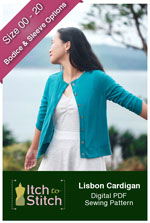digital mila shirt sewing pattern
The Mila Shirt is your Fall and Winter staple. Using a light-weight fabric, such as rayon challis, you can create a flowy look. And with a medium-weight fabric, such as flannel, you can have a classic, cozy look. The Mila Shirt is loose fitting so it is perfect for layering.
-
Itch to Stitch Digital Patterns
This style is provided as a digital pattern. It may be printed on home printers that use either 8 1/2" x 11" or A4 paper or at a print shop that can print A0-sized pattern sheets. When you complete your order, you will be provided with a unique code to instantly download the pattern. See our digital product policy for full details.
All Itch to Stitch patterns come as multiple PDF files consolidated within a single .zip file. Download and save the .zip file to a computer to access the PDF files. Downloading .zip files to mobile devices is not recommended as most phones and tablets cannot open them.
Description
The Mila Shirt is your Fall and Winter staple. Using a light-weight fabric, such as rayon challis, you can create a flowy look. And with a medium-weight fabric, such as flannel, you can have a classic, cozy look. The Mila Shirt is loose fitting so it is perfect for layering.
Mila Shirt features:
- A, B, C, D and DD cups for the perfect fit
- Center-front, button-down placket for a casual look
- Classic high-low shirttail hem
- Integrated front and back yoke
- Slight gathers at front for subtle shaping
- Optional collar (or collar band only without collar)
- Optional sleeve tabs to secure rolled up sleeves
- Optional front pocket
- Layers feature–print only the sizes you need
Suggested Fabrics
Primary Fabric: Use light to medium-weight woven fabric. Shirting, broadcloth, linen, flannel and crepe are great choices. Interfacing: Use light- to medium- weight fusible woven or weft insertion interfacing.
Notions
- Five (5) 5/8" (1.6 cm) buttons
- Two (2) more 5/8" (1.6 cm) buttons for the optional sleeve tabs
Size Chart, Finished Measurements, and Fabric Requirements
Click to enlarge the final images at above right.
Choosing your Size
- Determine your cup size. You can use the cup size you typically wear.
- After determining the cup size, compare your bust circumference (fullest part) to the “Body Measurements” table. Using the corresponding row for your cup, choose the size that best fits your bust. If you are between sizes, choose the smaller size if you like your garment more fitted; otherwise, choose the bigger size.
- It’s OK to use different sizes for the bust and waist. All you have to do is print the sizes that you need (see “Printing Instructions” and “Blend Sizes” in the instructions), and blend the lines from one size to the next from the bust to the bust to the waist.
- Compare your waist circumference (narrowest part) to the “Body Measurements” table. Choose the size that best fits your waist. If you are between sizes, choose the smaller size if you like your garment more fitted; otherwise, choose the bigger size.
- Compare your hip circumference (widest part) to the “Body Measurements” table. Choose the size that best fits your hips. If you are between sizes, choose the smaller size if you like your garment more fitted; otherwise, choose the bigger size.
- It’s OK to use different sizes for the bust, waist and hip. All you have to do is print the sizes that you need (see “Printing Instructions” and “Blend Sizes” in the instructions), and blend the lines from one size to the next from the bust to the waist to the hip.
- If you are taller than 5’7” (170 cm) or shorter than 5’4” (163 cm), you should consider lengthening or shortening the bodice (see “Lengthen/Shorten” in the instructions), unless you have long/short torso.
- It is highly recommended that you check your fit by making a test garment with inexpensive fabrics that have similar weight as your final garment fabrics.
-
Be the first to review this item.









